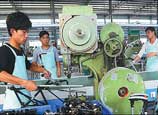
Always known as a country with "large population and abundant labor force", China is now faced with a new change in the population structure: decline in the labor force and increase in the aging population.
The latest bulletin released by the National Bureau of Statistics reveals that the working-age population of Chinese mainland dropped by 0.6 percentage points in the end of 2012 over the end of the previous year. This is reportedly the first-time drop in the absolute number of working-age population in China since quite a long time ago.
This data also mean that the "demographic dividend," which has always been considered as an important factor in China's economic growth miracles, has now come to an inflection point.
Many people worry that the gradual disappearance of demographic dividend will affect economic growth. However, experts said this is not necessarily a bad thing. The inflection point can form a "reversed transmission of pressure" mechanism to accelerate the transformation of economic growth mode; meanwhile, China has huge potential in the secondary development of demographic dividend. Therefore, the inflection point is not necessarily subject to pessimistic interpretation.
Working age population will gradually decrease
Demographic dividend refers to the economic consequences brought by changes in population age structure in the process of demographic transition.
Cai Fang, director of the Institute of Population and Labor Economics, Chinese Academy of Social Sciences said there are two indicators to judge whether a country has demographic dividend: first, the working-age population; and second, the population dependency ratio, which is the quotient obtained using the working-age population to divide other population groups including the underage and the elderly.
Cai said, a growing working-age population and declining dependency ratio bring population dividend; and conversely, there is no demographic dividend.
"Demographic dividend" made substantial contribution to China's economic growth. According to World Bank estimates, such a structural advantage made more than 30 percent contribution to the high economic growth in China. But the contribution of demographic dividend started to decrease since the beginning of the 21st century.
Cai said China's working-age population is decreasing and the dependency ratio is rising correspondingly. With the producing force getting smaller while the consuming population getting bigger, China's demographic dividend will tend to disappear.
Ma Jiantang, director of the National Bureau of Statistics said China's working-age population will steadily and gradually reduce in a relatively long period of time, at least before 2030.

















 Beijing Film Academy releases list of re-examination
Beijing Film Academy releases list of re-examination


![]()
